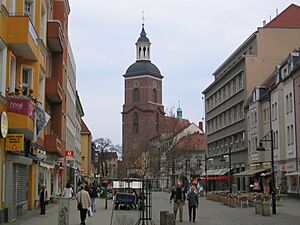Spandau facts for kids
Quick facts for kids
Spandau
|
||
|---|---|---|
|
Borough of Berlin
|
||
|
||
| Country | Germany | |
| State | Berlin | |
| City | Berlin | |
| Population
(2012-11-30)
|
||
| • Total | 231,540 | |
| Time zone | CET/CEST (UTC+1/+2) | |
| Vehicle registration | B | |
| Website | Official homepage: http://www.berlin.de/ba-spandau/index.html | |
Spandau is a cool part of Berlin, located in the very west. It sits right by the Havel River, where it meets the Spree River. Spandau is one of Berlin's many boroughs, which are like big neighborhoods.
This area covers about 91.91 km2 (35.5 sq mi). As of 2003, around 226,100 people lived here. The person in charge of Spandau, like its local leader, is called the mayor. The current mayor is Helmut Kleebank from the SPD.
Contents
Exploring Spandau's Past
The story of Spandau began a very long time ago, around the 700s or 800s. At that time, a group of people called Slavs settled here. They built a strong fort to protect themselves.
Early History and City Rights
In 928, a German king named Henry I took over the fort. But it later went back to Slavic rule in the 10th century. The first time Spandau was written about was in 1197. It officially became a city in 1232, which meant it had special rights.
Fortresses and Conflicts
A famous fortress called the Spandau Citadel was finished in 1594. It was built by Joachim II of Brandenburg. In 1558, a nearby village called Gatow became part of Spandau. Later, in 1634, Spandau was taken over by Swedish forces.
In 1806, after a big battle, French soldiers led by Napoleon took control of Spandau. They stayed there until 1807. Napoleon returned in 1812. In 1813, Prussian and Russian soldiers surrounded the Spandau Citadel.
Spandau Joins Berlin
In 1920, the city of Spandau officially became a borough of Berlin. Before World War I, Spandau was known for making weapons. It had large factories that produced cannons, gunpowder, and other war supplies.
After World War II
After World War II, Spandau was part of the area controlled by the United Kingdom in West Berlin. The Spandau Prison, built in 1876, was used to hold important figures from the war who were sentenced to prison. After the last person held there, Rudolf Hess, passed away, the prison was completely taken down. A supermarket was built where the prison once stood. When the Allied forces left Berlin, this military supermarket became a regular store and a parking lot.
Modern Spandau and Pop Culture
Today, Spandau is home to different industries. These include working with metal, making chemicals, and producing carpets.
You might have heard of the popular British band, Spandau Ballet. They actually got their name from Spandau!
Places to Visit in Spandau
Spandau has some interesting historical places you can explore:
- Spandau Citadel: This is a cool fortress that was built in the 16th century. It's a great example of old military architecture.
- St. Nikolai Church: This church dates back to the Middle Ages. There's another church with the same name in Berlin-Mitte, so make sure you're visiting the one in Spandau!
Spandau's Sister Cities
Spandau has special friendships with other cities around the world. These are called "twin towns" or "sister cities." They often share culture and ideas. Spandau is twinned with:
 Germany Siegen and Kreis Siegen-Wittgenstein
Germany Siegen and Kreis Siegen-Wittgenstein  North Rhine-Westphalia (since 1952)
North Rhine-Westphalia (since 1952) United Kingdom Luton (since 1959)
United Kingdom Luton (since 1959) France Asniéres-sur-Seine (since 1959)
France Asniéres-sur-Seine (since 1959) Israel Ashdod (since 1968)
Israel Ashdod (since 1968) Turkey Iznik (since 1968)
Turkey Iznik (since 1968) Germany Nauen
Germany Nauen  Brandenburg (since 1988)
Brandenburg (since 1988)
See also
 In Spanish: Distrito de Spandau para niños
In Spanish: Distrito de Spandau para niños



